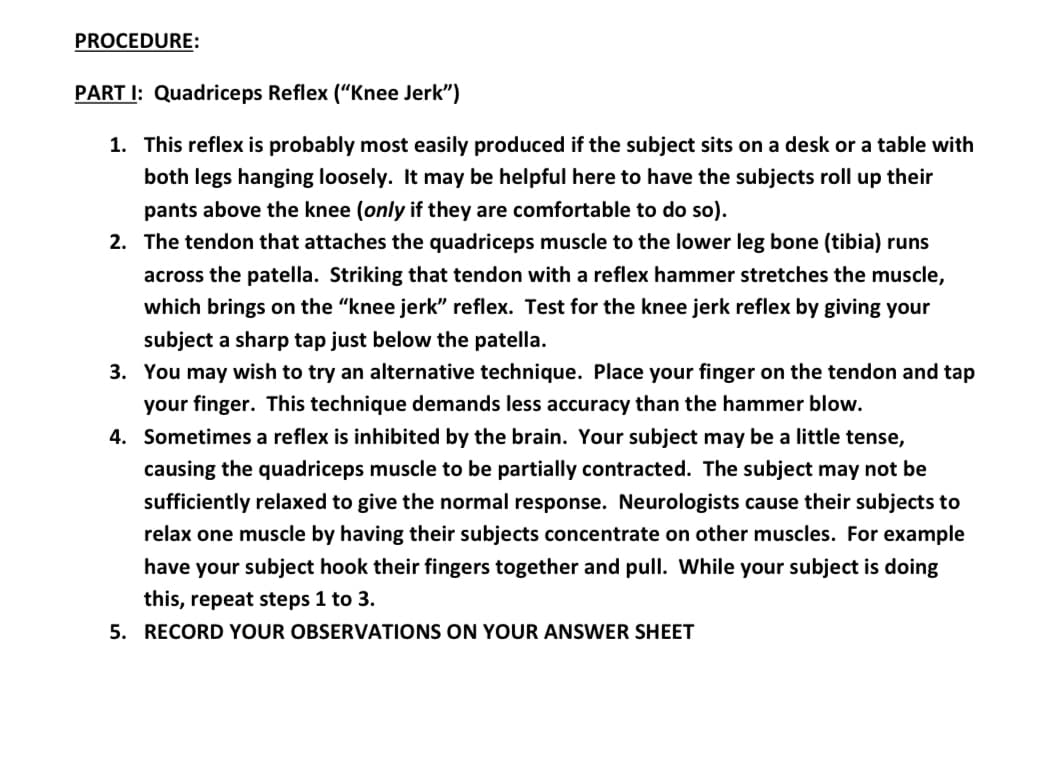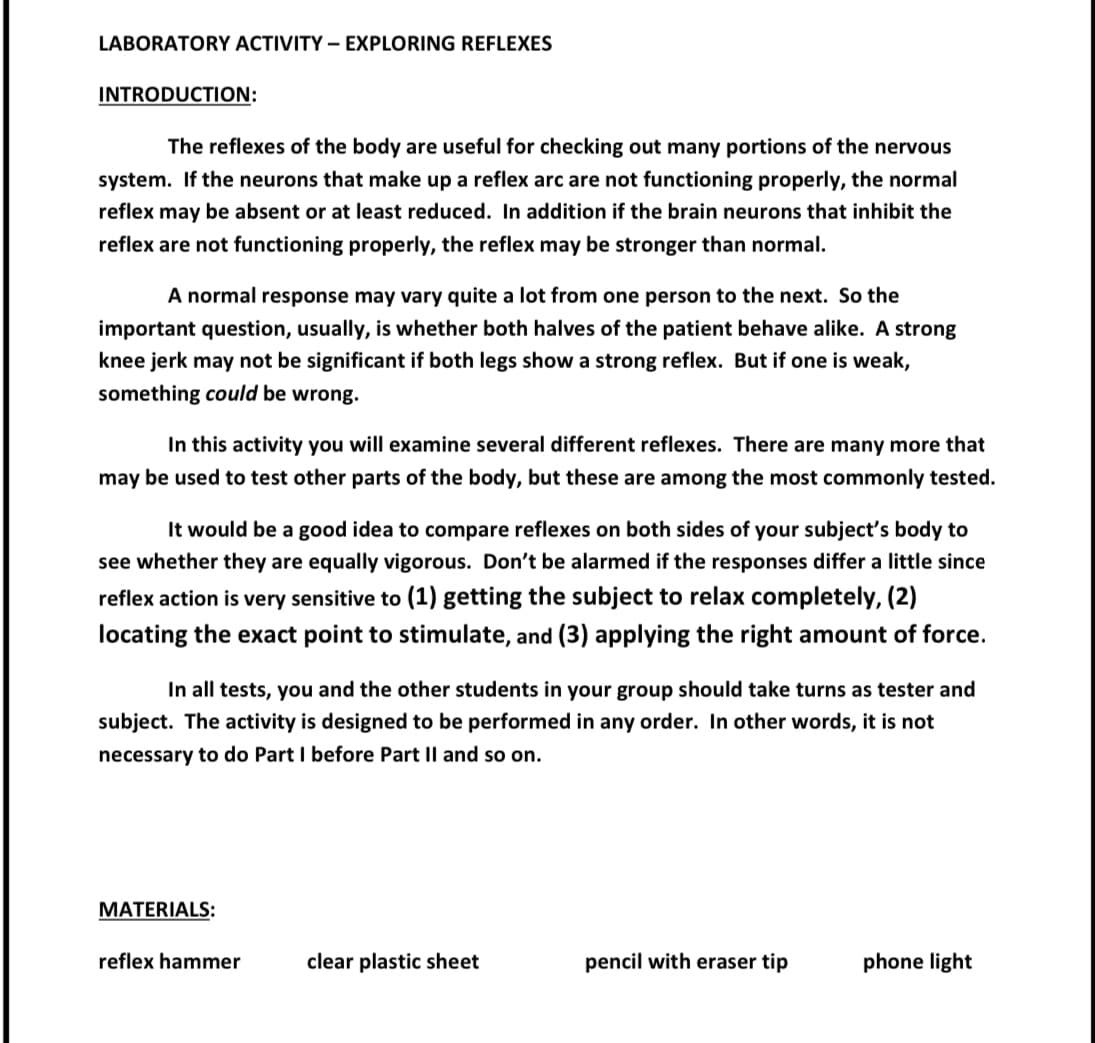You probably found that you could increase the quadriceps reflex action by having the subject clasp fingers and pull the arms in opposite directions. Why do you think this helps produce the reflex?
You probably found that you could increase the quadriceps reflex action by having the subject clasp fingers and pull the arms in opposite directions. Why do you think this helps produce the reflex?
Anatomy & Physiology
1st Edition
ISBN:9781938168130
Author:Kelly A. Young, James A. Wise, Peter DeSaix, Dean H. Kruse, Brandon Poe, Eddie Johnson, Jody E. Johnson, Oksana Korol, J. Gordon Betts, Mark Womble
Publisher:Kelly A. Young, James A. Wise, Peter DeSaix, Dean H. Kruse, Brandon Poe, Eddie Johnson, Jody E. Johnson, Oksana Korol, J. Gordon Betts, Mark Womble
Chapter16: The Neurological Exam
Section: Chapter Questions
Problem 7ILQ: Watch this video (http://openstaxcollege.org/l/reflextest) to see how to test reflexes in the...
Related questions
Question
You probably found that you could increase the quadriceps reflex action by having the subject clasp fingers and pull the arms in opposite directions. Why do you think this helps produce the reflex?

Transcribed Image Text:PROCEDURE:
PART I: Quadriceps Reflex ("Knee Jerk")
1. This reflex is probably most easily produced if the subject sits on a desk or a table with
both legs hanging loosely. It may be helpful here to have the subjects roll up their
pants above the knee (only if they are comfortable to do so).
2. The tendon that attaches the quadriceps muscle to the lower leg bone (tibia) runs
across the patella. Striking that tendon with a reflex hammer stretches the muscle,
which brings on the "knee jerk" reflex. Test for the knee jerk reflex by giving your
subject a sharp tap just below the patella.
3. You may wish to try an alternative technique. Place your finger on the tendon and tap
your finger. This technique demands less accuracy than the hammer blow.
4. Sometimes a reflex is inhibited by the brain. Your subject may be a little tense,
causing the quadriceps muscle to be partially contracted. The subject may not be
sufficiently relaxed to give the normal response. Neurologists cause their subjects to
relax one muscle by having their subjects concentrate on other muscles. For example
have your subject hook their fingers together and pull. While your subject is doing
this, repeat steps 1 to 3.
5. RECORD YOUR OBSERVATIONS ON YOUR ANSWER SHEET

Transcribed Image Text:LABORATORY ACTIVITY - EXPLORING REFLEXES
INTRODUCTION:
The reflexes of the body are useful for checking out many portions of the nervous
system. If the neurons that make up a reflex arc are not functioning properly, the normal
reflex may be absent or at least reduced. In addition if the brain neurons that inhibit the
reflex are not functioning properly, the reflex may be stronger than normal.
A normal response may vary quite a lot from one person to the next. So the
important question, usually, is whether both halves of the patient behave alike. A strong
knee jerk may not be significant if both legs show a strong reflex. But if one is weak,
something could be wrong.
In this activity you will examine several different reflexes. There are many more that
may be used to test other parts of the body, but these are among the most commonly tested.
It would be a good idea to compare reflexes on both sides of your subject's body to
see whether they are equally vigorous. Don't be alarmed if the responses differ a little since
reflex action is very sensitive to (1) getting the subject to relax completely, (2)
locating the exact point to stimulate, and (3) applying the right amount of force.
In all tests, you and the other students in your group should take turns as tester and
subject. The activity is designed to be performed in any order. In other words, it is not
necessary to do Part I before Part II and so on.
MATERIALS:
reflex hammer
clear plastic sheet
pencil with eraser tip
phone light
Expert Solution
This question has been solved!
Explore an expertly crafted, step-by-step solution for a thorough understanding of key concepts.
This is a popular solution!
Trending now
This is a popular solution!
Step by step
Solved in 2 steps

Knowledge Booster
Learn more about
Need a deep-dive on the concept behind this application? Look no further. Learn more about this topic, biology and related others by exploring similar questions and additional content below.Recommended textbooks for you

Anatomy & Physiology
Biology
ISBN:
9781938168130
Author:
Kelly A. Young, James A. Wise, Peter DeSaix, Dean H. Kruse, Brandon Poe, Eddie Johnson, Jody E. Johnson, Oksana Korol, J. Gordon Betts, Mark Womble
Publisher:
OpenStax College

Biology: The Dynamic Science (MindTap Course List)
Biology
ISBN:
9781305389892
Author:
Peter J. Russell, Paul E. Hertz, Beverly McMillan
Publisher:
Cengage Learning

Anatomy & Physiology
Biology
ISBN:
9781938168130
Author:
Kelly A. Young, James A. Wise, Peter DeSaix, Dean H. Kruse, Brandon Poe, Eddie Johnson, Jody E. Johnson, Oksana Korol, J. Gordon Betts, Mark Womble
Publisher:
OpenStax College

Biology: The Dynamic Science (MindTap Course List)
Biology
ISBN:
9781305389892
Author:
Peter J. Russell, Paul E. Hertz, Beverly McMillan
Publisher:
Cengage Learning